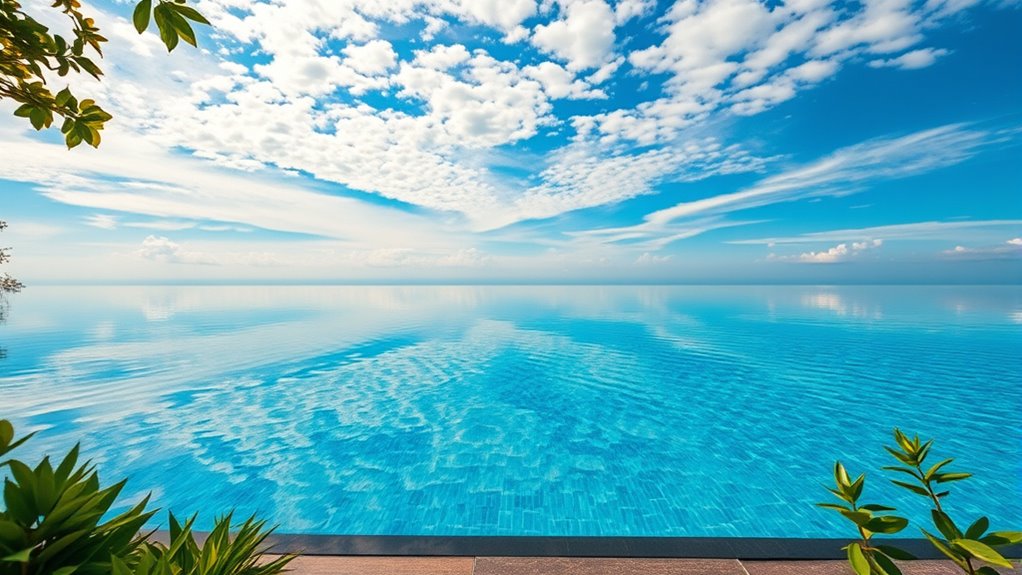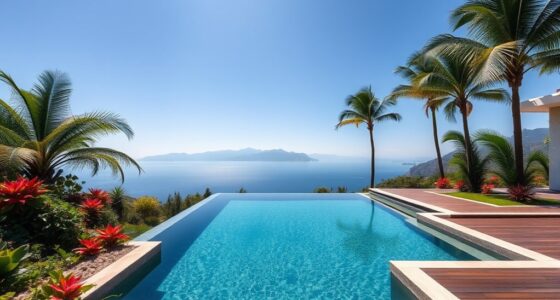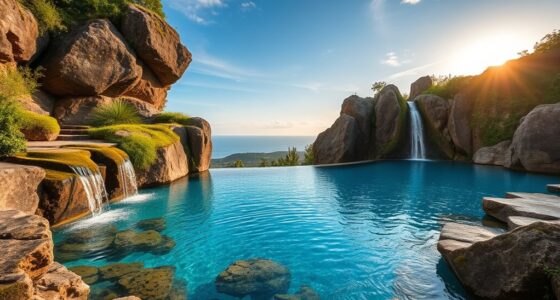To master reflection in infinity pool photography, understand how light interacts with the water surface, influenced by angle, surface tension, and environment. Calm, undisturbed water creates sharper, clearer reflections, while disturbances like wind cause distortion. The surrounding landscape, light conditions, and time of day also shape reflection quality. By controlling these elements and experimenting with angles, you’ll capture stunning mirror-like images. Keep exploring to reveal more secrets behind creating mesmerizing reflections.
Key Takeaways
- Reflection quality depends on water surface tension, which is influenced by temperature and surface disturbances.
- Calm, smooth water surfaces produce clearer, mirror-like reflections essential for stunning infinity pool images.
- Light angle, time of day, and environmental surroundings shape the clarity, color, and contrast of reflections.
- Material edges and surrounding landscape affect how reflections are captured, adding depth and mood to the photograph.
- Proper composition and timing optimize reflection symmetry and minimize disturbances for visually striking infinity pool shots.
Understanding Light and Its Behavior on Water Surfaces

Light interacts with water surfaces in fascinating ways, creating reflections, distortions, and shimmering effects. When sunlight hits the water, some of it reflects directly, forming mirror-like images, while the rest penetrates, refracting and bending as it passes through the surface. This refraction causes objects beneath the water to appear distorted or shifted, adding depth to your photos. The angle at which light strikes the water greatly influences the clarity and strength of reflections. During different times of day, the sun’s position changes the way light interacts with the surface, altering the visual effects. Understanding these behaviors helps you anticipate how your shots will look under various conditions. Mastering the interplay of light and water is key to capturing stunning infinity pool images. Knowing how light behaves in water surfaces allows you to better predict and enhance the visual impact of your photographs.
The Role of Surface Tension in Reflection Clarity
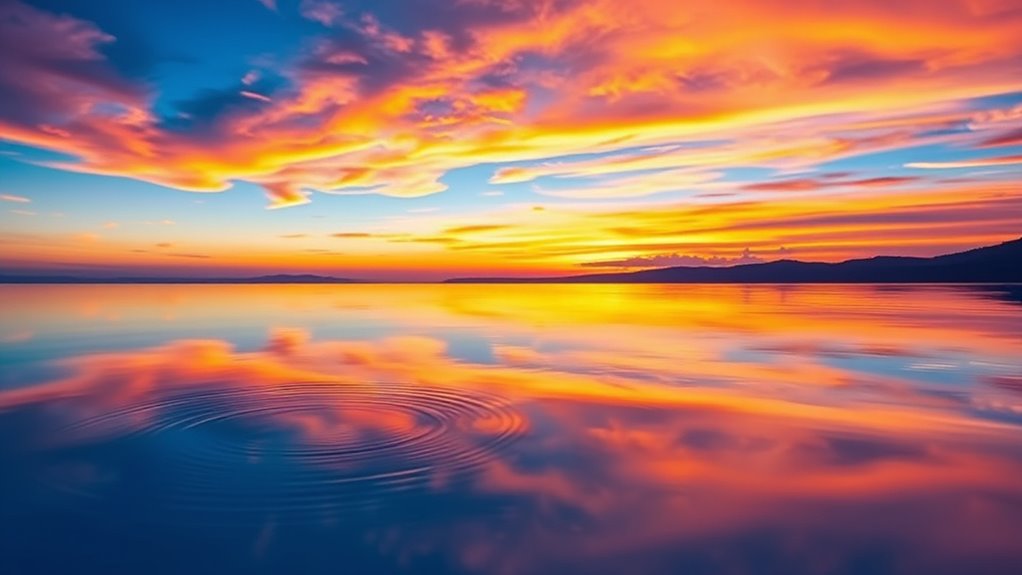
Your ability to capture sharp reflections depends on water’s surface tension, which keeps the water smooth and cohesive. When the surface is calm and even, reflections are clearer, but temperature shifts can cause ripples that distort the view. Understanding these factors helps you control the conditions for perfect infinity pool shots. Additionally, Natural Language Processing advancements can be utilized to analyze environmental conditions, enabling photographers to predict optimal times for capturing flawless reflections.
Water’s Cohesive Properties
Surface tension plays a essential role in creating the mirror-like reflections in infinity pool photography. It results from water molecules sticking closely together due to cohesive forces, forming a smooth surface. This cohesive property allows water to resist external disturbances, maintaining a flat, glassy appearance ideal for reflections. When you capture an image, water’s cohesive nature ensures a continuous, unbroken surface, reflecting the sky, surroundings, and light with clarity. The stronger the cohesion, the less the water surface distorts under minor disturbances like wind or movement. This stability is fundamental for achieving sharp, pristine reflections. Understanding water’s cohesive properties helps you anticipate how the water will behave under different conditions, enabling you to optimize your shot for maximum reflection clarity.
Impact of Surface Smoothness
The smoothness of the water’s surface directly impacts the clarity of reflections in infinity pool photography. When the surface is flat and undisturbed, reflections appear sharp and mirror-like. Surface tension plays an essential role here, holding the water together in a cohesive sheet. To maximize reflection clarity, consider these factors:
- Minimize disturbances like wind or movement that cause ripples.
- Use a calm, still time of day for shooting, such as early morning.
- Ensure the pool’s surface remains free of debris or algae that could disrupt smoothness.
- Adjust angles to favor direct reflection, reducing visual interference.
- Incorporating advanced AI technology can help analyze water surface conditions to optimize shot timing and angles.
Effects of Temperature Variations
Temperature variations markedly influence the surface tension of water, which in turn affects reflection clarity in infinity pool photography. When water is warmer, surface tension decreases, making the water more prone to disturbances from wind or movement. This causes ripples and small waves that distort reflections, reducing clarity. Conversely, cooler water increases surface tension, stabilizing the surface and creating a smoother, more mirror-like reflection. Sudden temperature changes, such as nighttime cooling or sunlight warming, can create uneven surface tension, leading to inconsistent reflection quality. To capture sharp, clear reflections, aim for ideal temperature conditions that promote stable water surfaces. Monitoring temperature and understanding its effect on surface tension allows you to anticipate reflection quality and adjust your shooting timing accordingly. Additionally, water temperature plays a crucial role in maintaining consistent surface tension and, thus, reflection clarity.
Angle of Incidence and Reflection: Achieving Perfect Symmetry
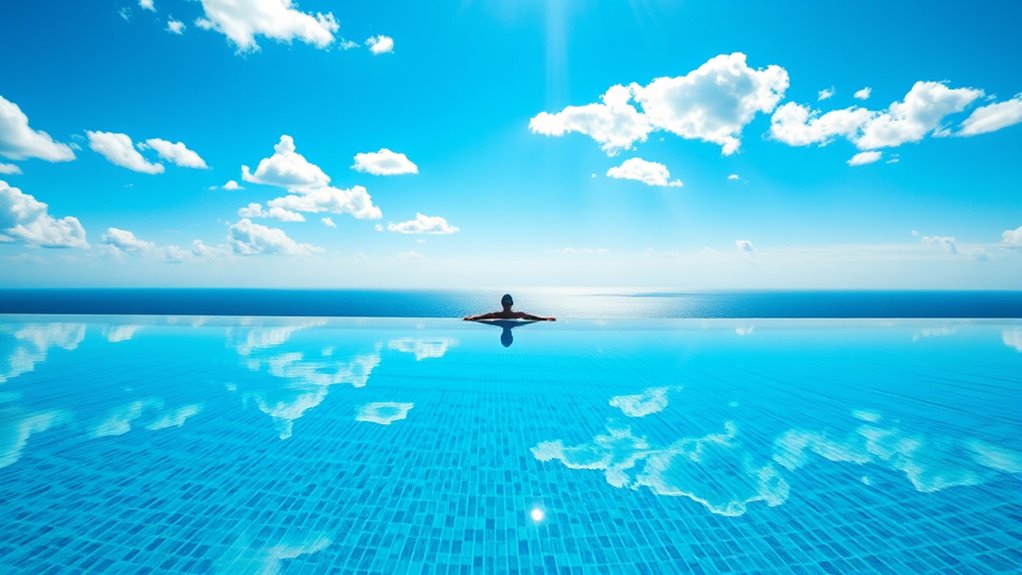
Understanding the relationship between the angle of incidence and the angle of reflection is key to capturing perfect symmetry in infinity pool photography. When you position your camera, aim to align the incoming light with the reflection angle to create mirror-like images. Here’s how to do it:
- Keep your camera at the same angle as the surface of the water.
- Use a tripod to stabilize your shot and maintain consistent angles.
- Observe how light hits the water and adjust your position accordingly.
- Experiment with different angles until the reflection lines up perfectly with the scene above the pool.
- Remember that consistent messaging and understanding light behavior are essential for authentic and stunning captures consistent messaging.
Mastering this balance ensures that the reflection mirrors the environment accurately, resulting in stunning, symmetrical images that highlight the infinity pool’s unique beauty.
How Surface Disturbances Affect Reflection Quality
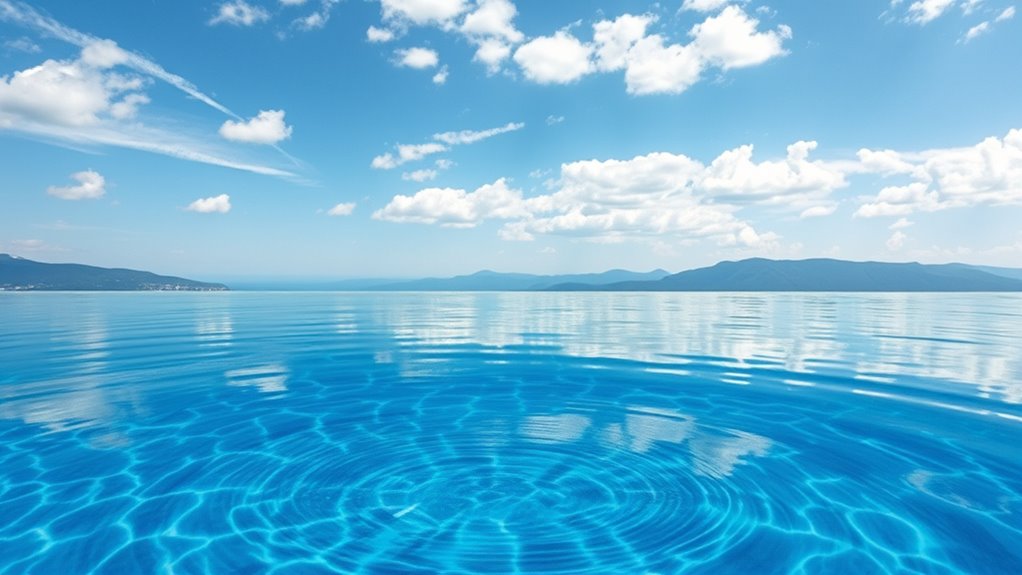
Surface disturbances such as ripples, waves, or debris can markedly degrade reflection quality in infinity pool photography. These irregularities disrupt the smooth surface needed for clear, mirror-like reflections. Even slight movements caused by wind, swimmers, or falling debris distort the reflected image, making it appear blurry or fragmented. To illustrate, consider how different disturbances impact reflection:
| Disturbance Type | Effect on Reflection |
|---|---|
| Ripples | Create wavy, distorted reflections |
| Waves | Cause large, unsteady surface shifts |
| Debris | Interrupt reflection continuity |
| Wind | Generates persistent surface movement |
Minimizing surface disturbances is key to achieving sharp, enthralling reflections. Keep the pool calm by controlling environment factors and timing your shots for ideal stillness. Environmental conditions such as weather and surroundings play a significant role in maintaining a tranquil reflective surface.
The Impact of Surrounding Environment on Reflection Dynamics
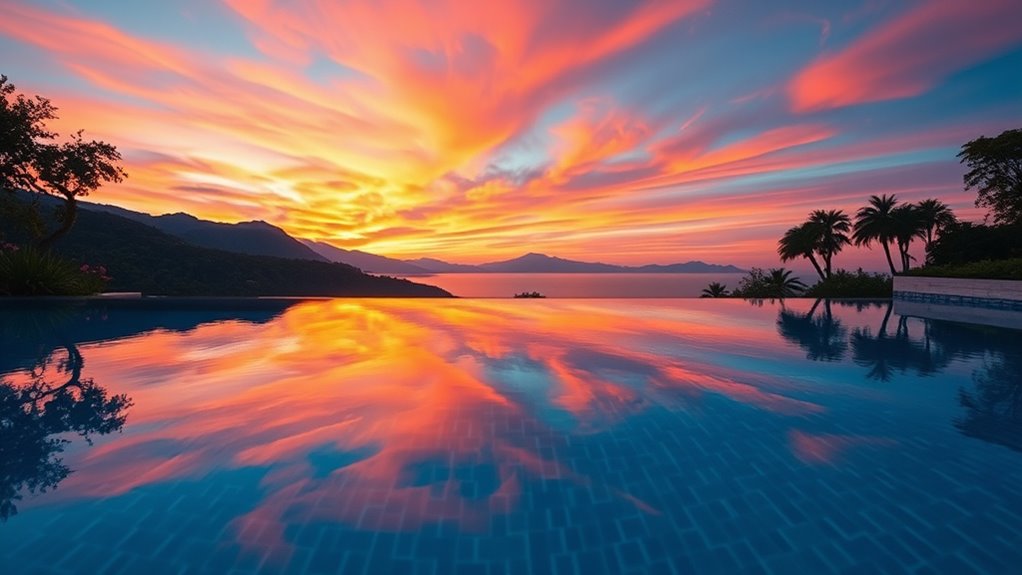
The environment around your infinity pool considerably shapes how reflections appear and shift. The surface material influences how smoothly reflections form, while light and shadow create contrast and mood. Additionally, the surrounding landscape adds context and complexity to the reflected images you capture. Practicing mindful observation of these elements can enhance your appreciation of natural beauty and improve your photographic results. decluttering strategies
Surface Material Influence
The materials surrounding an infinity pool considerably shape how reflections appear and evolve. They influence the clarity, color, and texture of reflections, directly affecting your photos. Different surfaces interact uniquely with water, creating distinct visual effects. For example:
- Glass walls produce sharp, mirror-like reflections that enhance symmetry.
- Stone or concrete edges add texture and often soften reflections, giving a more muted look.
- Metal fixtures introduce subtle highlights and can create glare, adding contrast.
- Natural surroundings like greenery or rocks reflect colors and shapes, enriching the overall scene.
Understanding these materials helps you anticipate how reflections will behave, allowing you to choose the right angles and settings for striking shots. Additionally, Volkswagen Tuning techniques can be applied to optimize camera settings for capturing reflections and surface interactions more effectively. The surrounding environment’s surface materials are key to capturing enthralling infinity pool images.
Light and Shadow Play
Light and shadows cast by the surrounding environment dramatically influence how reflections in an infinity pool unfold. When sunlight hits nearby structures, trees, or clouds, it creates patterns that dance across the water’s surface. These varying light intensities and shadow shapes add depth and dimension to your reflections, making them more dynamic. Bright sunlight enhances contrast, sharpening reflected details, while diffuse light softens edges, creating a more subtle mirror. Shadows cast by nearby objects can obscure or distort reflections, adding mystery or abstract qualities to your shot. You can manipulate these effects by timing your shoot during different times of the day or adjusting your angle. Additionally, understanding the water parks available in various locations can inspire creative poolside photography sessions, utilizing natural surroundings for unique reflection effects. Ultimately, understanding how light and shadow interplay helps you craft compelling, visually rich reflections in your infinity pool photography.
Surrounding Landscape Effect
Your surrounding landscape plays a crucial role in shaping the reflections seen in an infinity pool. It influences the colors, shapes, and overall mood captured in your shot. The landscape acts as a natural mirror, adding depth and context to your images. To optimize this effect, consider these factors:
- The horizon line’s position, which determines the extent of sky or land reflected.
- The presence of trees, mountains, or structures that add interesting shapes.
- Water features or greenery that contribute vibrant colors and textures.
- The weather conditions, such as clear skies or clouds, that alter reflection brightness and contrast.
- The choice of reflection solutions, such as positioning and angle, can further enhance the clarity and beauty of your reflections.
Using Composition to Enhance Reflective Effects
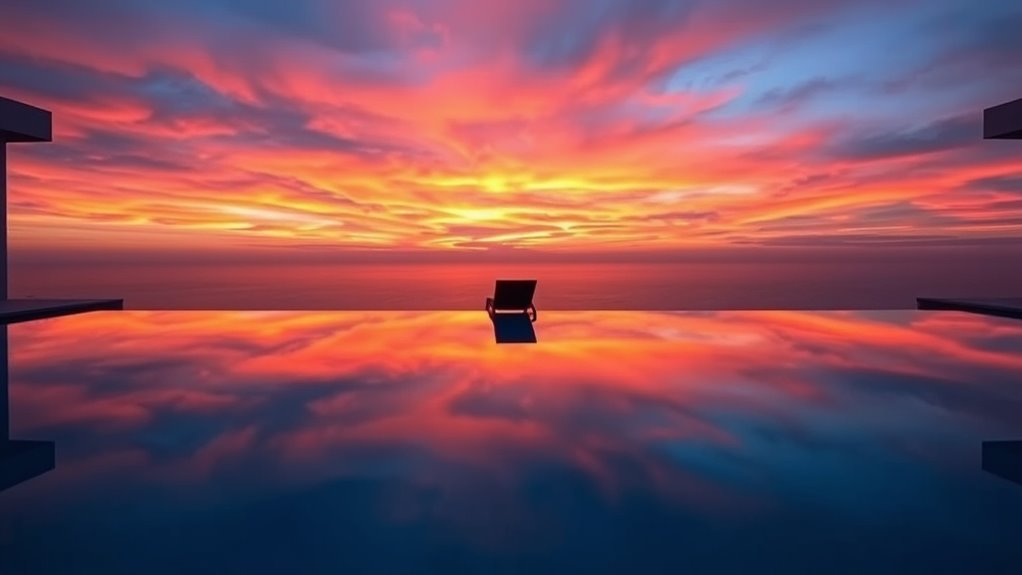
To effectively enhance reflective effects in infinity pool photography, carefully consider how you compose your shot. Position your camera to include interesting elements in the reflection, such as the sky, clouds, or surrounding architecture, creating a layered composition. Use leading lines, like the pool’s edge or natural features, to draw the viewer’s eye toward the reflection, emphasizing its depth. Keep the horizon line low or high to control how much of the reflection dominates the scene. Symmetry can amplify the mirror-like quality, so align the horizon and key elements carefully. Incorporate foreground objects to add context and dimension, making the reflection more dynamic. Thoughtful composition guides the viewer’s gaze and intensifies the reflective effect, making your photograph more compelling.
The Influence of Light Conditions and Time of Day
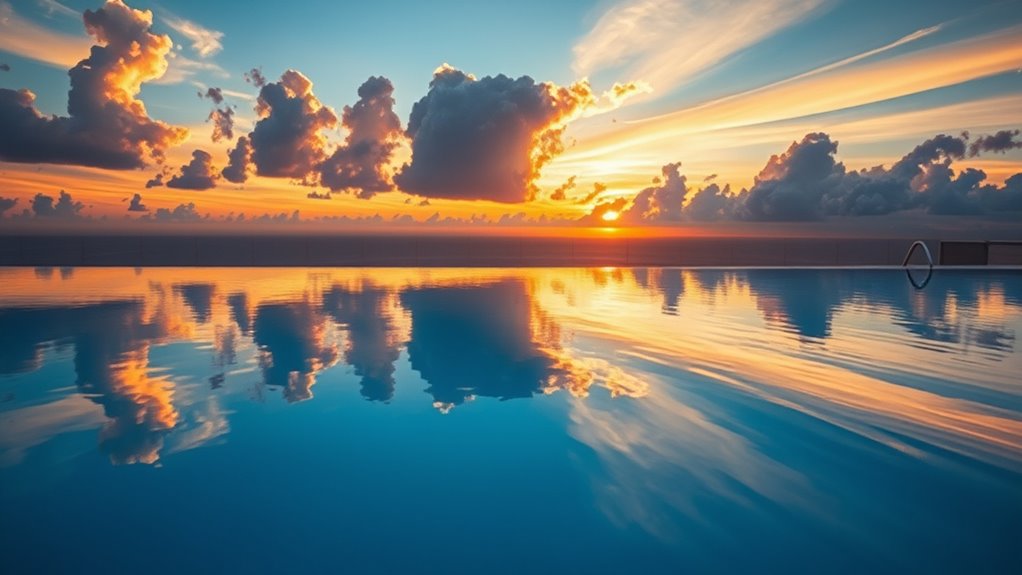
The time of day and prevailing light conditions play a crucial role in shaping the mood and clarity of your infinity pool reflections. During early morning or late evening, soft, warm light creates a serene atmosphere and gentle reflections. Midday sun produces harsh, bright light that can cause glare and reduce reflection clarity. Overcast days diffuse light evenly, resulting in muted, subtle reflections. To optimize your shots, consider these factors:
- Golden Hour: Capture reflections during sunrise or sunset for warm tones and a tranquil feel.
- Midday Sun: Avoid shooting when the sun is directly overhead to prevent glare.
- Cloud Cover: Use overcast skies to soften reflections and reduce harsh shadows.
- Weather Conditions: Calm weather offers still water, enhancing mirror-like reflections, while wind distorts the surface.
Techniques for Capturing Sharp and Vibrant Reflections
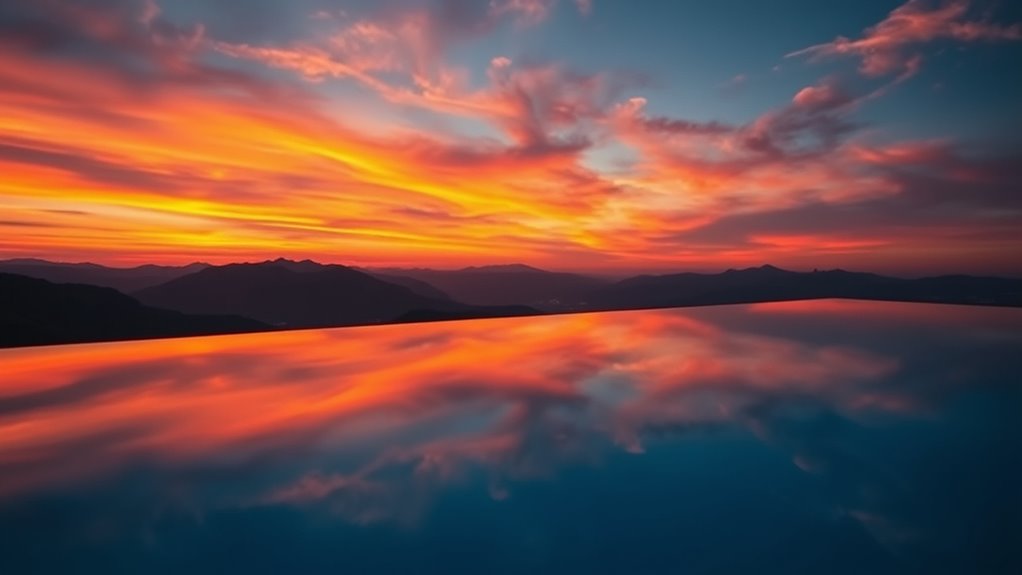
Capturing sharp and vibrant reflections in an infinity pool requires attention to detail and proper technique. First, choose a low ISO setting to minimize noise and maximize clarity. Use a small aperture, like f/8 to f/16, to ensure a deep depth of field, keeping both the reflection and surrounding details sharp. Stabilize your camera with a tripod to prevent motion blur, especially in low light. Shoot during calm weather—still water produces clearer reflections. Position yourself at a suitable angle, preferably near the edge, to capture the reflection’s symmetry and vibrancy. Wait for ideal lighting—early morning or late afternoon light enhances color saturation and reduces harsh shadows. Adjust your focus precisely on the reflective surface for crisp, lively images.
Post-Processing Tips to Enhance Reflection Visibility
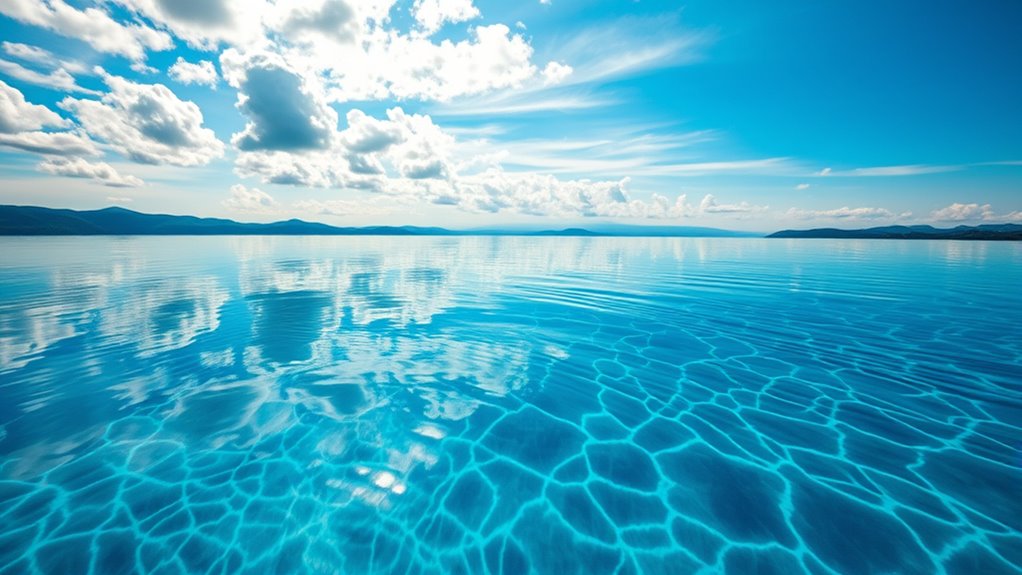
Enhancing reflection visibility in your photos often hinges on effective post-processing techniques. To make reflections stand out, start by adjusting the contrast and clarity to sharpen details. Next, use selective editing tools like the brush or masks to brighten or darken specific areas, emphasizing the reflection. Third, increase the saturation subtly to boost color intensity without oversaturating the scene. Finally, consider applying a slight vignette to draw focus toward the reflection, guiding the viewer’s eye. These steps help create a more striking mirror effect, ensuring your reflections catch the viewer’s attention. Remember, subtle adjustments often yield the best results, so avoid over-editing that could distort the natural beauty of your shot.
Creative Approaches to Using Reflection for Artistic Impact
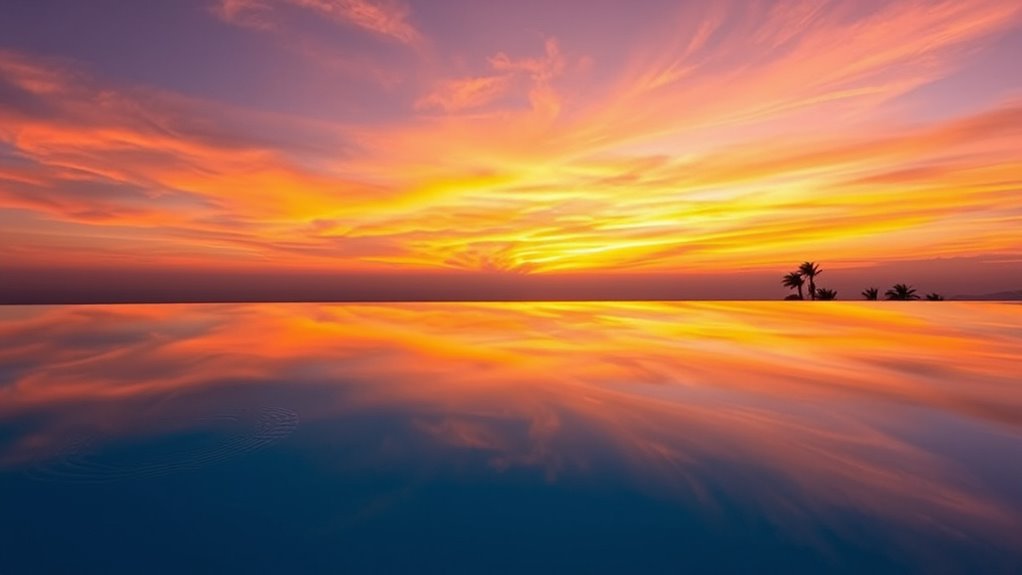
You can create striking images by emphasizing symmetry and balance between the pool and its reflection, drawing viewers into a harmonious scene. Playing with distorted perspectives can also add a surreal or dynamic feel that captures attention. Experimenting with these approaches allows you to turn reflections into powerful tools for artistic expression.
Symmetry and Balance
Symmetry and balance play a crucial role in creating visually striking infinity pool photographs, as they guide the viewer’s eye and evoke a sense of harmony. To achieve this, consider the following approaches:
- Align the horizon carefully to emphasize perfect symmetry.
- Use reflections to mirror architectural elements or natural features.
- Position your camera to capture central elements that create balanced compositions.
- Incorporate leading lines that draw attention to symmetrical focal points.
Distorted Perspectives
By deliberately angling your camera or adjusting your perspective, you can transform reflections in an infinity pool into mesmerizing distortions that challenge viewers’ perceptions. Instead of capturing a straightforward reflection, experiment with unconventional angles—shoot from above, below, or at oblique angles—to create warped, surreal images. You can also incorporate nearby objects or structures to enhance the distortion effect, making reflections appear stretched, compressed, or fragmented. Playing with focal length and depth of field further exaggerates or softens these distortions. The goal is to craft an image that draws viewers in with its unusual, abstract quality. This approach invites curiosity and encourages viewers to see ordinary reflections in a new, imaginative light.
Frequently Asked Questions
How Does Camera Lens Choice Influence Reflection Quality in Infinity Pool Photography?
Your choice of camera lens markedly affects reflection quality in infinity pool photography. Wide-angle lenses capture more of the scene and can emphasize reflections, creating dramatic effects. Telephoto lenses, on the other hand, isolate specific reflections, making them sharper and more detailed. Using a lens with a wide aperture allows you to control depth of field, which can soften or sharpen reflections, helping you craft the desired visual impact in your photos.
Can Polarization Filters Improve Reflection Clarity in Bright Conditions?
Yes, polarization filters can improve reflection clarity in bright conditions. They work by reducing glare and controlling the angle of reflected light, allowing you to see through surface reflections or enhance them for artistic effect. When you use a polarization filter, you can adjust it to minimize unwanted reflections or to intensify those you want to capture. This makes your images clearer, more vibrant, and better balanced in high-sun environments.
How Do Weather Conditions Like Wind or Rain Impact Reflection Sharpness?
Imagine you’re photographing an infinity pool during a windy day. The wind stirs the water, creating ripples that distort reflections, making them less sharp. Rain can similarly blur or obscure reflections, especially if it causes surface disturbances or introduces water droplets. Both wind and rain disrupt the stillness needed for crisp reflections, so you’ll get clearer images on calm, dry days. Planning your shoot around weather conditions guarantees the best reflection sharpness.
Are There Specific Camera Settings Optimal for Capturing Reflections?
You should set your camera to a small aperture, like f/11 or higher, to maximize depth of field and keep reflections sharp. Use a low ISO to reduce noise and a tripod to stabilize your shot. Adjust your shutter speed based on lighting conditions to get proper exposure. Shooting in manual mode allows you to control focus precisely, ensuring your reflections are clear and well-defined in your infinity pool photos.
How Does the Depth of Water Affect the Appearance of Reflections?
The depth of water considerably influences how reflections appear in your photos. Shallow water tends to produce clearer, more defined reflections because the surface is more responsive to subtle disturbances. Deeper water can create a softer, more diffused reflection, often adding a sense of mystery or tranquility. Adjust your angle and focus accordingly to enhance the reflection’s clarity or softness, depending on the mood you want to convey.
Conclusion
By mastering these reflection secrets, you’ll turn your infinity pool shots into mesmerizing portals to another world—where water becomes glass, light dances endlessly, and symmetry defies reality. With perfect angles, pristine surfaces, and expert timing, you’ll create images so stunning, they’ll make viewers question what’s real. Get ready to release your inner photographer and transform every shot into a breathtaking masterpiece that leaves everyone spellbound—your reflections will become legendary.
